Sioux
| Sioux Očhéti Šakówį |
|---|
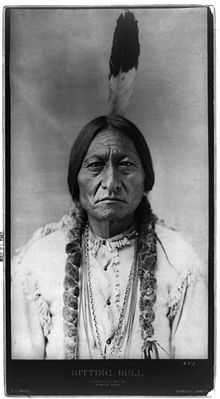 |
| Sitting Bull, a Hunkpapa Lakota chief and holy man, circa 1885. |
| Total population |
| Regions with significant populations |
| Languages |
| English, Sioux |
| Religion |
| Christianity (incl. syncretistic forms), Midewiwin |
| Related ethnic groups |
| Assiniboine, Stoney (Nakoda), and other Siouan peoples |
Sioux (pronounced SUE) are a Native American and First Nations people. The term can refer to any ethnic group within the Great Sioux Nation or any of the nation's many dialects. The Sioux comprise three major divisions based on dialect and subculture:
- Isanti ("Knife," originating from the name of a lake in present-day Minnesota): residing in the extreme east of the Dakotas, Minnesota, and northern Iowa, and are often referred to as the Santee or Eastern Dakota.
- Ihanktowan-Ihanktowana ("Village-at-the-end" and "little village-at-the-end"): residing in the Minnesota River area, they are considered to be the middle Sioux, and are often referred to as the Yankton or Western Dakota.
- Teton or Tetonwan (uncertain, perhaps "Dwellers on the Prairie"): the westernmost Sioux, known for their hunting and warrior culture, and are often referred to as the Lakota.
Today, the Sioux maintain many separate tribal governments scattered across several reservations, communities, and reserves in the Dakotas, Minnesota, Nebraska, and also in Manitoba and southern Saskatchewan in Canada.
Contents |
Oceti Sakowin
The historical Sioux referred to the Great Sioux Nation as the Oceti Sakowin (Očhéti Šakówį [oˈtʃʰetʰi ʃaˈkʰowĩ]), meaning "Seven Council Fires". Each fire was symbolic of an oyate (people or nation). The seven nations that comprise the Sioux are: Mdewakanton, Wahpetowan (Wahpeton), Wahpekute, Sissetowan (Sisseton), the Ihantowan (Yankton), Ihanktowana (Yanktonai), and the Teton (Lakota).[3] The Seven Council Fires would assemble each summer to hold council, renew kinships, decide tribal matters, and participate in the Sun Dance.[4] The seven divisions would select four leaders known as Wicasa Yatapicka from among the leaders of each division.[4] Being one of the four leaders was considered the highest honor for a leader; however, the annual gathering meant the majority of tribal administration was cared for by the usual leaders of each division. The last meeting of the Seven Council Fires was in 1850.[4]
Today the Teton, Isanti, or Ihantowan/Ihanktowana are usually known, respectively, as the Lakota, Eastern Dakota, or Western Dakota.[3] In any of the three main dialects, "Lakota, Dakota" all translate to mean "friend," or more properly, "ally." Usage of Lakota, Dakota may then refer to the alliance that once bound the Great Sioux Nation together.
Political organization
The historical political organization was based on the participation of individuals and the cooperation of many to sustain the tribe’s way of life. Leaders were chosen based upon noble birth and demonstrations of bravery, fortitude, generosity, and wisdom.[4]
Political leaders were members of the Naca Ominicia society and decided matters of tribal hunts, camp movements, whether to make war or peace with their neighbors, or any other community action.[5] Societies were similar to fraternities; men joined to raise their position in the tribe. Societies were composed of smaller clans and varied in number among the seven divisions.[4] There were two types of societies: Akicita, for the younger men, and Naca, for elders and former leaders.[4]
Akicita ("Warrior") societies existed to train warriors, hunters, and to police the community.[5] There were many smaller Akicita societies, including the Kit-Fox, Strong Heart, Elk, and so on.[5] Leaders in the Naca societies, per Naca Ominicia, were the tribal elders and leaders, who would elect seven to ten men, depending on the division, each referred to as Wicasa Itancan ("chief man"). Each Wicasa Itancan interpreted and enforced the decisions of the Naca.[5]
The Wicasa Itancan would elect two to four Shirt Wearers who were the voice of the society. They settled quarrels among families and also foreign nations.[4] Shirt Wearers were often young men from families with hereditary claims of leadership. However, men with obscure parents who displayed outstanding leaderships skills and had earned the respect of the community might also be elected. Crazy Horse is an example of a common-born "Shirt Wearer".[4]
A Wakincuza ("Pipe Holder") ranked below the "Shirt Wearers". The Pipe Holders regulated peace ceremonies, selected camp locations, and supervised the Akicita societies during buffalo hunts.[5]
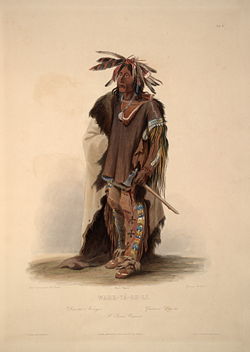

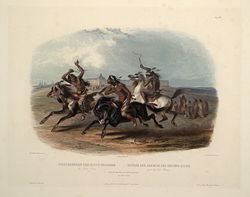
Name origins
The name "Sioux" is an abbreviated form of Nadouessioux borrowed into French Canadian from Nadoüessioüak from the early Odawa exonym: naadowesiwag "Sioux".[6] It was first used by Jean Nicolet in 1640.[3] The Proto-Algonquian form *na·towe·wa, meaning "Northern Iroquoian", has reflexes in several daughter languages that refer to a small rattlesnake (massasauga, Sistrurus).[7] This information was interpreted by some that the Ottawa borrowing was an insult. However, this Proto-Algonquian term most likely was ultimately derived from a form *-a·towe·, meaning simply "speak foreign language",[6] which was later extended in meaning in some Algonquian languages to refer to the massasauga. Thus, contrary to many accounts, the old Odawa word naadowesiwag did not equate the Sioux with snakes. This is not confirmed though, since usage over the previous decades has led to this term having negative connotations to those tribes to which it refers. This would explain why many tribes have rejected this term when referring to themselves.
Some of the tribes have formally or informally adopted traditional names: the Rosebud Sioux Tribe is also known as the Sicangu Oyate, and the Oglala often use the name Oglala Lakota Oyate, rather than the English "Oglala Sioux Tribe" or OST. (The alternative English spelling of Ogallala is considered improper).[3]
Linguistics
The earlier linguistic 3-way division of the Dakotan branch of the Siouan family identified Lakota, Dakota, and Nakota as dialects of a single language, where Lakota = Teton, Dakota = Santee and Yankton, Nakota = Yanktonai & Assiniboine. This classification was based in large part on each group's particular pronunciation of the autonym Dakhóta-Lakhóta-Nakhóta, meaning the Yankton-Yanktonai, Santee, and Teton groups all spoke mutually intelligible varieties of a Sioux idiom.[7] However, more recent study identifies Assiniboine and Stoney as two separate languages with Sioux being the third language that has three similar dialects: Teton, Santee-Sisseton, Yankton-Yanktonai. Furthermore, the Yankton-Yanktonai never referred to themselves using the pronunciation Nakhóta but rather pronounced it the same as the Santee (i.e. Dakhóta). (Assiniboine and Stoney speakers use the pronunciation Nakhóta or Nakhóda).
The term Dakota has also been applied by anthropologists and governmental departments to refer to all Sioux groups, resulting in names such as Teton Dakota, Santee Dakota, etc. This was mainly because of the misrepresented translation of the Ottawa word from which Sioux is derived supposedly meaning "snake."[4]
Modern geographic divisions
The Sioux maintain many separate tribal governments scattered across several reservations and communities in the Dakotas, Minnesota, Nebraska,South Carolina and also in Manitoba and southern Saskatchewan in Canada.
The earliest known European record of the Sioux was in Minnesota, Iowa, and Wisconsin.[7] Furthermore, after the introduction of the horse, the Sioux dominated larger areas of land—from present day Canada to the Platte River, from Minnesota to the Yellowstone River, including the Powder River country.[5]
Isanti (Santee or Dakota)
The Isanti migrated north and westward from the south and east into Ohio then to Minnesota. Some came up from the Santee River and Lake Marion, area of South Carolina which takes its name from them and where some of their ancient mounds can still be seen along the portion of the damned-up river that forms Lake Marion. In the past, they were a woodland people who thrived on hunting, fishing and subsistence farming. Migrations of Anishinaabe/Chippewa (Ojibwa) people from the east in the 17th and 18th centuries, with muskets supplied by the French and British, pushed the Dakota further into Minnesota and west and southward, giving the name "Dakota Territory" to the northern expanse west of the Mississippi River and up to its headwaters.[7]
Ihanktonwan-Ihanktonwana (Yankton-Yanktonai)
The Ihanktowan-Ihanktowana, or the Yankton (Ihanktowan: "End village") and Yanktonai (Ihanktowana: "Little end village") divisions consist of two bands or two of the seven council fires. According to Nasunatanka and Matononpa in 1880, the Yanktonai are divided into two sub-groups known as the Upper Yanktonai and the lower Yanktonai (Hunkpatina).[7]
Economically, they were involved in quarrying pipestone. The Yankton-Yanktonai moved into northern Minnesota. In the 18th century, they were recorded as living in the Mankato region of Minnesota.[8]
Teton (Lakota)
The Sioux likely obtained horses sometime during the seventeenth century (although some historians date the arrival of horses in South Dakota to 1720). The Teton (Lakota) division of the Sioux emerged as a result of this introduction. Dominating the northern Great Plains with their light cavalry, the western Sioux quickly expanded their territory further to the Rocky Mountains (or Heska, "white mountains"). The Lakota once subsisted on the buffalo hunt, and on corn traded with the eastern Sioux and with their linguistic cousins the Mandan and Hidatsa along the Missouri.[7]
Ethnic divisions
The Sioux are divided into three ethnic groups, the larger of which are divided into sub-groups, and further branched into bands. The Yankton-Yanktonai, the smallest division, reside on the Yankton reservation in South Dakota and the Northern portion of Standing Rock Reservation. The Santee live on reservations, reserves, and communities in Minnesota, Nebraska, South Dakota, North Dakota, and Canada. The Lakota are the westernmost of the three groups, occupying lands in both North and South Dakota. Today, many Sioux also live outside their reservations.
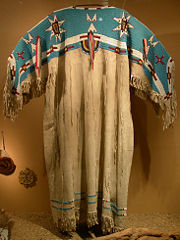
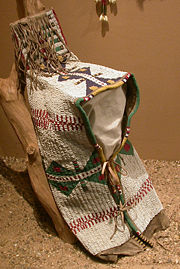
- Santee division (Dakota)
- Mdewakantonwan ("Spirit Lake Village")
- notable persons: Taoyateduta
- Sisitonwan (Sisseton, uncertain, perhaps "Fishing Grounds Village")
- Wahpekute ("Leaf Archers")
- notable persons: Inkpaduta
- Wahpetonwan ("Leaf Village")
- Mdewakantonwan ("Spirit Lake Village")
- Yankton-Yanktonai division (Western Dakota)
- Ihanktonwan (Yankton, "End Village")
- Ihanktonwana (Yanktonai, "Little End Village")
- notable persons: Wanata, Chief War Eagle
- Stone sub-division (Nakoda)
- Titonwan/Teton division (Lakota) (Uncertain, perhaps "Dwellers on the Prairie"):
- Oglala (Uncertain, perhaps "Those Who Scatter Their Own")
- notable persons: Crazy Horse, Red Cloud, Black Elk and Billy Mills (Olympian)
- Hunkpapa (meaning "Those who Camp by the Door" or "Wanderers")
- notable persons: Sitting Bull
- Sihasapa ("Blackfoot Sioux," not to be confused with the Algonquian-speaking Blackfeet)
- Minniconjou ("Those who Plant by the Stream")
- notable persons: Lone Horn, Touch the Clouds
- Sićangu (French: Brulé) ("Burnt Thighs")
- Itazipacola (French: Sans Arcs "Without Bows")
- Oohenonpa ("Two Kettles" or "Two Boilings")
- Oglala (Uncertain, perhaps "Those Who Scatter Their Own")
Reserves and First Nations
Today, one half of all enrolled Sioux in the United States live off the reservation. Also, to be an enrolled member in any of the Sioux tribes in the United States, 1/4 degree is required.[9]
In Canada, the Canadian government recognizes the tribal community as "First Nations." The land-holdings of the these First Nations are called "Reserves".
Modern reservations, reserves, and communities of the Sioux
| Reserve/Reservation | Community | Bands residing | Location |
|---|---|---|---|
| Fort Peck Indian Reservation | Assiniboine and Sioux Tribes | Hunkpapa, Upper Yanktonai (known as the Cut Head; Pabaksa), Mdewakantonwan, Wahpekute, Sisseton, Wahpeton, Assiniboine (Canoe Paddler, Red Bottom) | Montana, USA |
| Spirit Lake Reservation
(Formerly Devil's Lake Reservation) |
Spirit Lake Tribe
(Mni Wakan Oyate) |
Wahpeton, Sisseton, Upper Yanktonai | North Dakota, USA |
| Standing Rock Indian Reservation | Standing Rock Sioux Tribe | Upper Yanktonai, Hunkpapa, Blackfoot | North Dakota, South Dakota, USA |
| Lake Traverse Indian Reservation | Sisseton Wahpeton Oyate | Sisseton, Wahpeton | South Dakota, USA |
| Flandreau Indian Reservation | Flandreau Santee Sioux Tribe | Mdewakanton, Wahpekute, Wahpeton | South Dakota, USA |
| Cheyenne River Indian Reservation | Cheyenne River Sioux Tribe | Minneconjou, Blackfoot, Two Kettle, Sans Arc | South Dakota, USA |
| Crow Creek Indian Reservation | Crow Creek Sioux Tribe | Lower Yanktonai | South Dakota, USA |
| Lower Brule Indian Reservation | Lower Brule Sioux Tribe | Brulé | South Dakota, USA |
| Yankton Sioux Indian Reservation | Yankton Sioux Tribe | Yankton | South Dakota, USA |
| Pine Ridge Indian Reservation | Oglala Lakota | Oglala, few Brulé | South Dakota, USA |
| Rosebud Indian Reservation | Rosebud Sioux Tribe (also as Sicangu Lakota or Upper Brulé Sioux Nation)
(Sićangu Oyate) |
Sićangu, few Oglala | South Dakota, USA |
| Upper Sioux Indian Reservation | Upper Sioux Community
(Pejuhutazizi Oyate) |
Mdewakanton, Sisseton, Wahpeton | Minnesota, USA |
| Lower Sioux Indian Reservation | Lower Sioux Indian Community | Mdewakanton, Wahpekute | Minnesota, USA |
| Shakopee-Mdewakanton Indian Reservation
(Formerly Prior Lake Indian Reservation) |
Shakopee Mdewakanton Sioux Community | Mdewakanton, Wahpekute | Minnesota, USA |
| Prairie Island Indian Community | Prairie Island Indian Community | Mdewakanton, Wahpekute | Minnesota, USA |
| Mille Lacs Lake Indian Reservation | Mille Lacs Band of Ojibwe (Mille Lacs Indians, St. Croix Chippewa Indians of Minnesota) | Ojibwa, Mdewakanton | Minnesota, USA |
| St. Croix Indian Reservation | St. Croix Chippewa Indians of Wisconsin | Ojibwa, Mdewakanton | Wisconsin, USA |
| Santee Indian Reservation | Santee Sioux Nation | Mdewakanton, Wahpekute | Nebraska, USA |
| Sioux Valley Dakota Nation Reserve, Fishing Station 62A Reserve* | Sioux Valley First Nation | Sisseton, Mdewakanton, Wahpeton, Wahpekute | Manitoba, Canada |
| Dakota Plains Indian Reserve 6A | Dakota Plains Wahpeton First Nation | Wahpeton, Sisseton | Manitoba, Canada |
| Dakota Tipi 1 Reserve | Dakota Tipi First Nation | Wahpeton | Manitoba, Canada |
| Birdtail Creek 57 Reserve, Birdtail Hay Lands 57A Reserve, Fishing Station 62A Reserve* | Birdtail Sioux First Nation | Mdewakanton, Wahpekute, Yanktonai | Manitoba, Canada |
| Canupawakpa Dakota First Nation Reserve, Oak Lake 59A Reserve, Fishing Station 62A Reserve* | Canupawakpa Dakota Nation | Wahpekute, Wahpeton, Yanktonai | Manitoba, Canada |
| Standing Buffalo 78 Reserve | Standing Buffalo Dakota First Nation | Sisseton, Wahpeton | Saskatchewan, Canada |
| Whitecap Reserve | Whitecap Dakota First Nation | Wahpeton, Sisseton | Saskatchewan, Canada |
| Dakota Plains Wahpeton First Nation | Wahpeton | Saskatchewan, Canada | |
| Wood Mountain 160 Reserve, Treaty Four Reserve Grounds Indian Reservation 77* | Wood Mountain | Hunkpapa | Saskatchewan, Canada |
| Carry the Kettle Nakota First Nation Indian Reserves, Assiniboine 76 Reserve, Treaty Four Reserve Grounds Indian Reservation 77* | Carry the Kettle First Nation | Assiniboine | Saskatchewan, Canada |
| Little Black Bear 84 Reserve, Treaty Four Reserve Grounds Indian Reservation 77* | Little Black Bear Cree-Assiniboine First Nation | Cree, Assiniboine | Saskatchewan, Canada |
| Mosquito 109 Reserve, Grizzly Bear's Head 110 & Lean Man 111 Reserves, Mosquito, Grizzly Bear's Head, Lean Man Treaty Land Entitlement Indian Reserve 1, Golden Eagle Indian Reserve | Mosquito, Grizzly Bears Head, Lean Man First Nations (Mosquito, Grizzly Bear's Head, Lean Man) | Assiniboine, Cree | Saskatchewan, Canada |
| White Bear 70 Reserve, Treaty Four Reserve Grounds Indian Reservation 77* | White Bear First Nation | Assiniboine, Cree, Ojibwa | Saskatchewan, Canada |
| Stoney 142-143-144 Reserves, Stoney 142B Reserve, Big Horn 144A Reserve, Eden Valley 216 Reserve | Bearpaw, Chiniki and Wesley | Stoney | Alberta, Canada |
- * Reserves shared with other First Nations
History
Alliance with French fur merchants
Late in the 17th century, the Dakota entered into an alliance with French merchants,[10] who were trying to gain advantage in the struggle for the North American fur trade against the English, who had recently established the Hudson's Bay Company.
Dakota War of 1862
When 1862 arrived shortly after a failed crop the year before and a winter starvation, the federal payment was late. The local traders would not issue any more credit to the Santee and one trader, Andrew Myrick, went so far as to tell them that they were 'free to eat grass or their own dung'. As a result, on August 17, 1862 the Dakota War began when a few Santee men murdered a white farmer and most of his family, igniting further attacks on white settlements along the Minnesota River. The Santee then attacked the trading post, and Myrick was later found among the dead with his mouth stuffed full of grass.[11]
On November 5, 1862 in Minnesota, in courts-martial, 303 Santee Sioux were found guilty of rape and murder of hundreds of American settlers and were sentenced to be hanged. No attorneys or witness were allowed as a defense for the accused, and many were convicted in less than five minutes of court time with the judge.[12] President Abraham Lincoln remanded the death sentence of 284 of the warriors, signing off on the execution of 39 Santee men by hanging on December 26, 1862 in Mankato, Minnesota, the largest mass-execution in U.S. history.[13]
Afterwards, annuities to the Dakota were suspended for four years and the money was awarded to the white victims. The men who were pardoned by President Lincoln were sent to a prison in Iowa, where more than half died.[12]
During and after the revolt, many Santee and their kin fled Minnesota and Eastern Dakota to Canada, or settled in the James River Valley in a short-lived reservation before being forced to move to Crow Creek Reservation on the east bank of the Missouri.[12] A few joined the Yanktonai and moved further west to join with the Lakota bands to continue their struggle against the United States military.[12]
Others were able to remain in Minnesota and the east, in small reservations existing into the 21st century, including Sisseton-Wahpeton, Flandreau, and Devils Lake (Spirit Lake or Fort Totten) Reservations in the Dakotas. Some ended up eventually in Nebraska, where the Santee Sioux Tribe today has a reservation on the south bank of the Missouri. Those who fled to Canada now have descendants residing on eight small Dakota Reserves, four of which are located in Manitoba (Sioux Valley, Long Plain [Dakota Tipi], Birdtail Creek, and Oak Lake [Pipestone]) and the remaining four (Standing Buffalo, Moose Woods [White Cap], Round Plain [Wahpeton], and Wood Mountain) in Saskatchewan.
Red Cloud's War
Red Cloud's War (also referred to as the Bozeman War) was an armed conflict between the Lakota and the United States in the Wyoming Territory and the Montana Territory from 1866 to 1868. The war was fought over control of the Powder River Country in north central Wyoming, which lay along the Bozeman Trail, a primary access route to the Montana gold fields.
The war is named after Red Cloud, a prominent Oglala chief who led the war against the United States following encroachment into the area by the U.S. military. The war ended with the Treaty of Fort Laramie, resulting in a complete victory for the Sioux and the temporary preservation of their control of the Powder River country.[14]
Great Sioux War of 1876-77
Between 1876 and 1877, the Great Sioux War of 1876-77 took place. The Lakota and their allies fought against the United States military in a series of conflicts. The earliest being the Battle of Powder River, and the final battle being at Wolf Mountain. Included are the Battle of the Rosebud, Battle of the Little Bighorn, Battle of Warbonnet Creek, Battle of Slim Buttes, Battle of Cedar Creek, and the Dull Knife Fight.
Wounded Knee Massacre

The Battle at Wounded Knee Creek was the last major armed conflict between the Lakota and the United States, subsequently described as a "massacre" by General Nelson A. Miles in a letter to the Commissioner of Indian Affairs.[15]
On December 29, 1890, five hundred troops of the U.S. 7th Cavalry, supported by four Hotchkiss guns (a lightweight artillery piece capable of rapid fire), surrounded an encampment of the Lakota bands of the Miniconjou and Hunkpapa [16] with orders to escort them to the railroad for transport to Omaha, Nebraska.
By the time it was over, 25 troopers and more than 150 Lakota Sioux lay dead, including men, women, and children. Some of the soldiers are believed to have been the victims of "friendly fire" because the shooting took place at point blank range in chaotic conditions.[17] Around 150 Lakota are believed to have fled the chaos, many of whom may have died from hypothermia.
Usage of the Ghost Dance reportedly instigated the massacre.
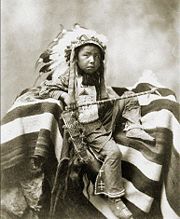
Forced relocation
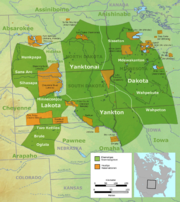
Later in the 19th century, as the railroads hired hunters to exterminate the buffalo herds, their primary food supply, the Santee and Lakota were forced to accept white-defined reservations in exchange for the rest of their lands, and domestic cattle and corn in exchange for buffalo, becoming dependent upon annual federal payments guaranteed by treaty. In Minnesota, the treaties of Traverse des Sioux and Mendota in 1851 left the Sioux with a reservation twenty miles (32 km) wide on each side of the Minnesota River.
Wounded Knee incident
The Wounded Knee incident began February 27, 1973 when the town of Wounded Knee, South Dakota was seized by followers of the American Indian Movement. The occupiers controlled the town for 71 days while the United States Marshals Service laid siege.
Republic of Lakota
The Lakotah Freedom Delegation, a group of Native American activists, declared on December 19, 2007 the Lakotah were withdrawing from all treaties signed with the United States to regain sovereignty over their nation. One of the activists, Russell Means, claims that the action is legal and cites Natural, International and U.S. law.[18] The group consider Lakotah to be a sovereign nation, although as yet the state is generally unrecognized. The proposed borders reclaim thousands of square kilometres of North and South Dakota, Wyoming, Nebraska and Montana.[19]
Derived names
The U.S. states of North Dakota and South Dakota are named for the Sioux. The name for Minnesota originated as the name of a river in the heart of Isanti territory: Mnisota (mni translates to "water" and sota means "hazy or smoky").
Several Midwestern municipalities utilize Sioux in their names, including Sioux City, Iowa, Sioux Center, Iowa, and Sioux Falls, South Dakota. Midwestern rivers include the Little Sioux River in Iowa and Big Sioux River along the Iowa/South Dakota border.
Many smaller towns and geographic features in the northern Great Plains retain their Sioux names (some are heavily Anglicized) or English translations of those names. These are: Wasta (from "Waste" meaning "good"), Owanka, Oacoma, Rapid City (Mne luza: "cataract" or "rapids"), Sioux Falls/Minnehaha County (Mne haha: "waterfall"), Inyan Kara, Sisseton (derived from the orgiinal tribal name "Sissetowan"), Winona ("first daughter"), etc.
Frontwoman Siouxsie Sioux of the postpunk band Siouxsie and the Banshees also derived her stage name from the "Sioux."
The University of North Dakota's athletic team is known as the "Fighting Sioux." While there is a local desire to retain the mascot, numerous Sioux tribes have issued resolutions asking the university to abolish it.[20][21]
Derived names from other Siouan languages
The name Nebraska comes from the related Chiwere language of the Siouan language family. Furthermore, the names of the states Kansas, Iowa, and Missouri derive from the names of other tribes within the Siouan language family: Kansa, Iowa, and Missouri, respectively. The names of the cities of Omaha, Nebraska and Ponca City, Oklahoma also derive from the Omaha and Ponca tribes. The names vividly demonstrate the wide dispersion of the Siouan language family across the Midwestern United States. Though they are considered part of the Siouan language family, none of these tribes or their languages are considered Sioux.
Media
- The HBO movie Bury My Heart at Wounded Knee depicts the relocations and reservations from the Sioux perspective.
- The films Dances with Wolves and Thunderheart contain depictions of the Sioux People.
- "Elegy to the Sioux," a poem by Norman Dubie
- The mini-series Into the West depicts the Sioux, specifically the Lakota, during some of first ventures of the "White Men" into the great plains and to the Rocky Mountains.
Famous Sioux
Historical
- Taoyateduta (Little Crow) — Chief famous for role in the Dakota War of 1862
- Tatanka Iyotanke (Sitting Bull) — Chief famous for role in the Battle of Little Bighorn
- Tasunka Witko (Crazy Horse) — Famous for leadership and courage in battle
- Mahpia Icahtagya (Touch the Clouds) - Famous for his legendary strength and size, a great warrior
- Makhpiya-luta (Red Cloud) — Chief famous for role in Red Cloud's War
- Tasunkakokipapi (Young Man Afraid Of His Horses) — Oglala chief who participated in Red Cloud's War
- Ishtakhaba (Sleepy Eye) — Chief of the Sisseton band in the mid 19th century; signed four treaties[22]
- Hehaka Sapa (Black Elk) — Lakota holy man, source of Black Elk Speaks and other books
- Tahca Ushte (Lame Deer) — Lakota holy man, carried traditional knowledge into modern era
- Ohiyesa Charles Eastman — Author, physician and reformer
- Colonel Gregory "Pappy" Boyington — World War II Fighter Ace and Medal of Honor recipient; 1/4 Sioux
- Wambditanka - Big Eagle - Mdewakanton Dakota chief - Narrated his account of the Dakota War of 1862
Contemporary
- Robert "Tree" Cody, Native American flautist (Dakota)
- Elizabeth Cook-Lynn, activist, academic, and writer
- Mary Crow Dog, writer and activist
- Vine Deloria, Jr., activist and essayist
- Indigenous, blues band (Nakota)
- Illinois Jacquet, jazz saxophonist (half Sioux and half African American)
- Russell Means, activist (Oglala)
- Ed McGaa, author, (Oglala) CPT US Marine Corp F-4 Phantom Fighter Pilot
- Billy Mills, only American ever to win the 10,000 meters at the Olympics (1964) – Oglala
- Eddie Spears, actor (Lakota Sioux Lower Brule)
- Michael Spears, actor (Lakota Sioux Lower Brule)
- Terry Ree, comedian
- John Trudell,activist, poet, actor
- Floyd Red Crow Westerman, singer and actor (Dakota)
- Leonard Peltier, imprisoned for allegedly killing two FBI agents in 1975
- Woodrow Keeble, (Sisseton Wahpeton Oyate) first Sioux Medal of Honor recipient for his valor during the Korean War
- Luther Standing Bear, Sioux author, actor, and rights activist
Notes
- ↑ "United States Census Data" (PDF). Retrieved on 2007-08-11.ew and their daughters 15 married 25 or over
- ↑ "Ethnologue Report for Lakota". Retrieved on 2007-08-11.
- ↑ 3.0 3.1 3.2 3.3 3.4 Johnson, Michael (2000). The Tribes of the Sioux Nation. Osprey Publishing Oxford. ISBN 185532878X.
- ↑ 4.0 4.1 4.2 4.3 4.4 4.5 4.6 4.7 4.8 Hassrick, Royal B.; Dorothy Maxwell, Cile M. Bach (1964). The Sioux: Life and Customs of a Warrior Society. University of Oklahoma Press. ISBN 0-8061-0607-7.
- ↑ 5.0 5.1 5.2 5.3 5.4 5.5 Mails, Thomas E. (1973). Dog Soldiers, Bear Men, and Buffalo Women: A Study of the Societies and Cults of the Plains Indians. Prentice-Hall, Inc.. ISBN 013-217216-X.
- ↑ 6.0 6.1 "Sioux". Dictionary.com. Retrieved on 2007-09-05.
- ↑ 7.0 7.1 7.2 7.3 7.4 7.5 Riggs, Stephen R. (1893). Dakota Grammar, Texts, and Ethnography. Washington Government Printing Office, Ross & Haines, Inc.. ISBN 0-87018-052-5.
- ↑ OneRoad, Amos E.; Alanson Skinner (2003). Being Dakota: Tales and Traditions of the Sisseton and Wahpeton. Minnesota Historical Society. ISBN 0-87351-453-X.
- ↑ "Enrollment Ordinance". Retrieved on 2007-08-11.
- ↑ van Houten, Gerry (1991). Corporate Canada An Historical Outline. Progress Books. pp. 6-7.
- ↑ Mark, Steil; Tim Post (2002-09-26). "m/part2.shtml Let them eat grass", Minnesota Public Radio. Retrieved on 2007-05-08.
- ↑ 12.0 12.1 12.2 12.3 Time-Life Books (1994). War for the Plains. Time-Life Books. ISBN 0-8094-9445-0.
- ↑ Mark, Steil; Tim Post (2002-09-26). "m/part5.shtml Execution and expulsion", Minnesota Public Radio. Retrieved on 2007-05-08.
- ↑ *Brown, Dee (1970). Bury My Heart at Wounded Knee, ch. 6. Bantam Books. ISBN 0-5531-1979-6.
- ↑ Letter: General Nelson A. Miles to the Commissioner of Indian Affairs, March 13, 1917.
- ↑ Liggett, Lorie (1998). "Wounded Knee Massacre - An Introduction". Bowling Green State University. Retrieved on 2007-03-02.
- ↑ Strom, Karen (1995). "The Massacre at Wounded Knee". Karen Strom.
- ↑ Descendants of Sitting Bull, Crazy Horse break away from US, Agence France-Presse news
- ↑ Bill Harlan (21 December 2007). "Lakota group secedes from U.S.", Rapid City Journal. Retrieved on 2007-12-28.
- ↑ "North Dakota to appeal ruling on Sioux mascot" (2005-09-25). Retrieved on 2007-08-18.
- ↑ "Tribal Resolutions and other Resolutions asking for the removal of the "Fighting Sioux" moniker and name". Retrieved on 2007-08-18.
- ↑ Upham, Warren (2001). Minnesota Place Names, A Geographical Encyclopedia, 3rd Edition. Saint Paul, Minnesota: Minnesota Historical Society. pp. pp. 75. ISBN 0-87351-396-7.